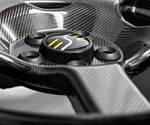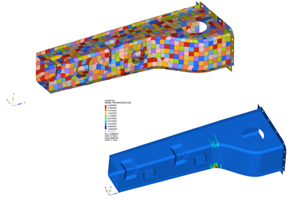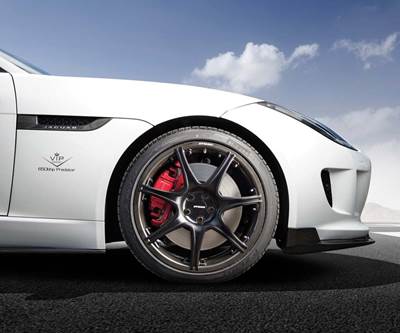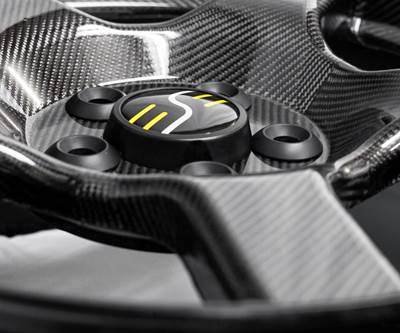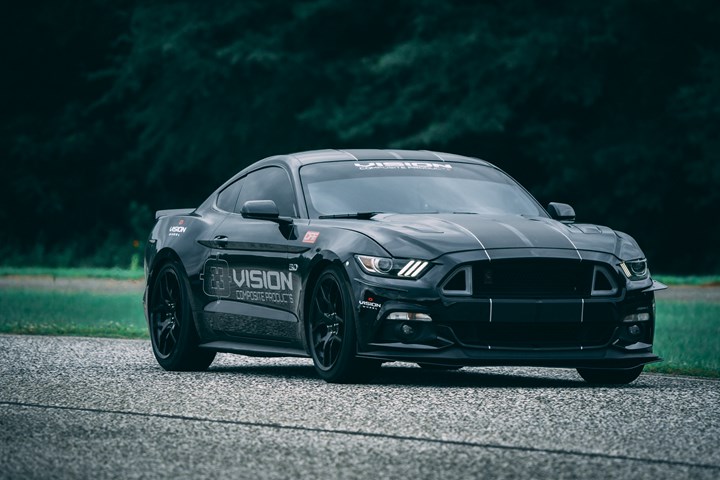
Achieving high-volume, low-cost composite wheels. Wheel manufacturer Vision Wheel sees high potential for carbon fiber wheels in future electric and high-performance vehicles. Working with partners IDI Composites International and A&P Technology, the company has developed its first composite wheels using what it says are a high-volume process and low-cost materials. Photo Credit: Vision Wheel
Lightweight, high-performance carbon fiber composite and metal-composite hybrid wheels have graced many a racecar or other high-performance vehicle in recent years, but high material costs and low-volume manufacturing methods have generally limited their market demand to the most premium cars. However, as more OEMs develop electric vehicles (EVs), demand may increase for lightweight wheels on production vehicles — if they can be built with lower cost materials at high volumes while still meeting stringent requirements.
One company seeking to change this paradigm is Vision Wheel (Decatur, Ala., U.S.), which has been manufacturing custom forged and cast aluminum wheels for more than 40 years in the passenger automotive, performance and specialty vehicle and utility terrain vehicle (UTV) markets. Under the name Vision Composite Products, the company debuted its first carbon fiber composite wheel at the CAMX exhibition in Dallas, Texas in October 2021, where the wheel was a finalist for a CAMX Award.
This new wheel is about nine years in the making, according to John Paul Mathew, COO of Vision Wheel. In 2010, several attempts were being made in the market to develop lighter, carbon fiber-based wheels, he says, and Vision Wheel CEO Roger Minor had the idea to develop a carbon fiber wheel that was not only lighter, but that could be manufactured in high volumes for the passenger vehicle market. “We have this vision that at some point the aluminum [wheel] market will be overtaken by carbon fiber,” Mathew explains.
Inventing the wheel: Original designs and hand layup
“We didn’t want to reinvent the wheel,” Mathew says. Vision Wheel looked at other carbon fiber wheel designs that were being developed — “they’re usually formed over a mandrel or some kind of foam core, making them look bigger than normal, or less contoured, or more plain than typical aluminum wheels” — and decided they wanted to mimic the complexity of a forged aluminum wheel as much as possible. For the first wheel, the company took the aluminum wheel used on the Shelby GT Mustang and mimicked the style using composites.
It was a difficult process, Mathew admits, and required many iterations, and a lot of back and forth between the finite element analysis (FEA) models and physical prototypes, tweaking the models according to how the prototypes were performing in reality.
The result is a two-piece wheel concept — a choice made for ease of manufacture, Mathew says — with the barrel or rim manufactured as a separate piece that is then assembled to the combined hub and spokes. Vision Wheel has various barrel tooling sizes that can be reused for many different wheel designs, while designs and tools for the spokes and hub are likely to be modified to meet the aesthetic requirements for each vehicle type and OEM.
For the first wheel iterations, the Vision Wheel team began by laying up continuous fabric by hand over mandrels. “The process was successful,” Mathew says, “but we realized that with that process, you can’t make millions of wheels a year. It’s tedious with long process cycles. We wanted to migrate and move to something that’s more focused on volume and mass production.” In addition, Vision Wheel needed to find composite materials that would pass stringent automotive test requirements.

Design freedom. Vision Wheel’s first direct-to-consumer wheels will be available for custom supercars and UTVs, but the company claims it can design to a wide variety of sizes and specifications to meet customer needs. Photo Credit: Vision Wheel
Meeting requirements: Materials development, new partners
Alan Dudley, engineering manager at Vision Wheel, explains that the U.S. Department of Transportation (DOT) requirements for wheels — tests for measuring minimum fatigue, impact, radial impact, etc. — were developed with the breaking points of aluminum and steel wheels in mind. “Plastic wheels do not fail in the same manner as aluminum wheels. When an aluminum wheel fails on impact, you see a crack in the spoke or other places, and it’s easily determined. With composites, it’s difficult to tell the severity of the crack — it can be surfacing, or delamination, or one of several things. But does it constitute a failure? That’s harder to determine.”
A particular challenge for composites, he adds, is passing temperature requirements — specifically in the supercar and powersports markets, where larger brakes and faster speeds can cause increased temperature on the wheels. “The tests are very robust, and it’s very difficult to get a composite material across the finish line,” he says. However, as more composite wheels are developed, new testing requirements are being developed by standards organization SAE International for composite wheels specifically, he notes.
In an effort to learn about new process techniques and materials that may be used to meet these requirements and Vision Wheel’s plans for high-volume production, the company got in touch with the Institute for Advanced Materials and Process Innovation (IACMI, Knoxville, Tenn., U.S.) and Purdue University’s Composite Manufacturing and Simulation Center (CMSC, West Lafayette, Ind., U.S.), and from there were introduced to material supplier IDI Composites International (Noblesville, Ind., U.S.).
“The two major goals were to reduce the material cost and the cycle times,” explains Kevin Cahill, director of technology and application engineering at IDI Composites. “These are two things IDI was very familiar with, given our background in SMC [sheet molding compound] and other compression molded materials.”
To keep material costs low, IDI and Vision Wheel first began looking at using an SMC comprising low-cost, fast-cure vinyl ester and a combination of chopped glass and carbon fibers. “We wanted to find the lowest cost solution that gave us the required strength,” Mathew says. About three years of development and iterations followed, leading to the use of all carbon fiber SMC to meet stiffness requirements in the wheels.
The carbon fiber SMC, Cahill says, almost met part requirements on its own. However, the discontinuous fiber composite was not strong enough to carry the highest stresses on the outside of the wheel on the spokes. About three years ago, it was decided that some amount of continuous fiber needed to be added into the mix, and so Cahill and IDI turned to braided material specialist A&P Technology (Cincinnati, Ohio, U.S.). Previously, IDI and A&P had worked together on a one-step process to co-mold A&P braided fabric into IDI SMC parts — specifically, they’d worked on a powered composite surfboard using A&P’s QISO fabric.
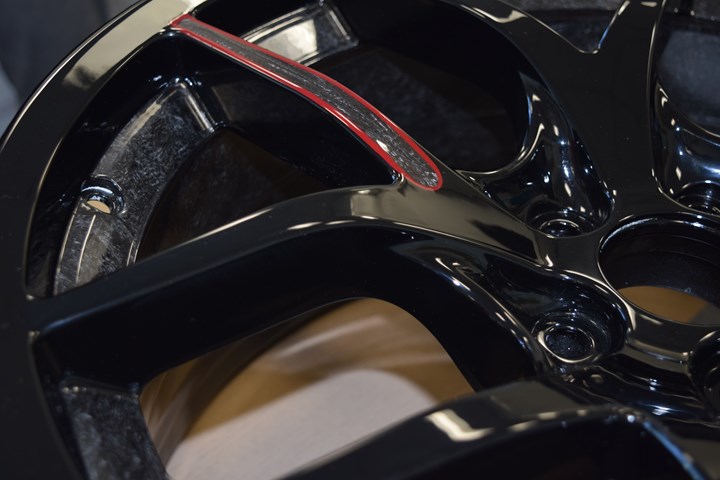
SMC + braided preform. After several years of development and testing, Vision Wheel’s current design combines SMC reinforced with continuous braided fiber in the spokes. Photo Credit: IDI Composites
For the wheel application, “the answer ended up being a more orthotropic and tailored material, in terms of orientation and directional reinforcement, that could be used to supplement the SMC in specific regions where the stresses were getting too high,” explains Mike Braley, VP of application development at A&P.
To meet impact test requirements, A&P’s net shape, continuous carbon fiber braided fabric preforms were introduced into the spokes of the wheel, and account for about 10% of the part’s overall weight. “It’s all about optimizing the braid architecture, so the fibers align exactly with the load they are going to see to maximize structural and cost efficiency,” notes Pam Schneider, COO at A&P. The biggest challenges, Braley adds, were working out the fiber orientation and figuring out a process to make sure the braid stayed in place during compression molding.
Ultimately, Mathew says, “we saw considerable strength improvements by adding [braided preform] inserts, but we were still seeing problems with the vinyl ester,” leading the teams to switch to higher performance, higher cost epoxy for both IDI’s chopped carbon fiber SMC (Ultrium U660) and A&P’s hybrid triaxial braided insert.
Cahill explains, “Some sections of the wheel need to be very thick, and vinyl ester tends to have thermal issues during heating on thick parts. Epoxies traditionally take a long time to cure — 60-90 minutes or down to 10 minutes with ‘snap-cure’ epoxies. For this, we use an epoxy that cures in 10 minutes or less, so it’s really aggressive and can meet automotive cycle times.”
Carbon Fiber Forged
The main barrel and hub of the wheel are made from IDI’s SMC in a compression molding process, and the spokes are co-molded with A&P’s braided preforms in one process step. Given the trademarked name Carbon Fiber Forged — “We wanted to give the image that these are replacing forged aluminum wheels,” Mathew says — Vision Wheel is keeping the specifics of its process close to the vest for now. “We can make a wheel in minutes instead of hours,” Mathew claims.
“Everything is done here in the U.S., with capacity at the end of 2021 for 8,000 units per year,” he says. The next goal is to increase local capacity in the company’s Alabama facility to at least 50,000 units per year. The company is also working towards ISO 9001, 14001 and TUV certifications for its facility. “Long term, we plan to build a factory capable of a million units per year,” he says.
First wheels to market and next steps
The first direct-to-consumer wheels Vision Wheel is selling include a 20- x 9.5-inch Mustang wheel and a 15- x 6-inch UTV wheel, with consumer prices expected to be less than $2,000 per wheel. The wheels are said to be 40% lighter than an aluminum wheel, and 60% lighter than steel. For performance cars and UTVs, this can contribute to higher performance and speed; in EVs, the lightweighting can contribute to better efficiency and range. The carbon fiber also helps with noise, vibration and harshness (NVH), Dudley adds, which is especially beneficial for the passenger EV market.
Compared to other carbon fiber composite wheel offerings, mass manufacturability of these wheels is the most obvious advantage. “There are other advantages that aren’t as evident,” Dudley notes. “For example, we’re not style limited.” Mimicking the aluminum Shelby GT wheel from the start wasn’t the fastest way to develop a wheel, he concedes, but starting with a high-performance, complex design first means that Vision Wheel now has the confidence to design to a variety of styles, geometries and performance qualifications.
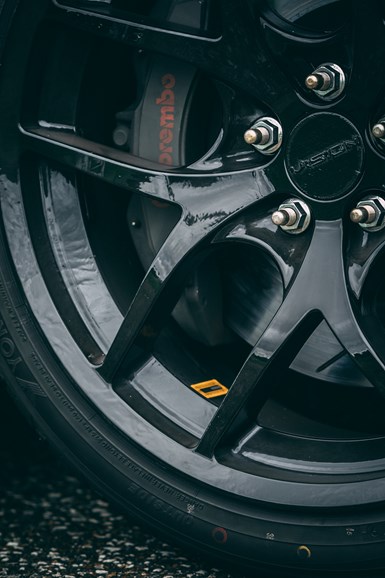
Ready to roll. The first direct-to-consumer wheels went on the market at the end of 2021. Next steps for Vision Wheel include scaling up production to serve OEMs directly. Photo Credit: Vision Wheel
Vision Wheel also manufactures 100% composite wheels without metallic lug nuts or other connecting components, and, Mathew adds, their materials and process are relatively low cost compared to others on the market. “Up to now, carbon fiber wheels have mainly only been used on high-dollar value supercars and racecars because of the costs to produce them. We’ll be able to enter [our wheels] into the market with a mid-value vehicle. That’s where we feel that the market can really expand,” he says.
“We have three markets we’re trying to attack: Performance track vehicles, powersports and — ultimately — OEM passenger electric vehicles,” Mathew explains.
Vision Wheel is targeting the first two markets first, and by the end of 2021 began selling its first direct-to-consumer wheels. “For the performance and powersports markets, light wheels equal higher performance,” and these vehicles tend to be produced in lower volumes, so these were obvious first steps, Mathew notes. The goal, though, is to begin scaling up production to the point where Vision Wheel can sell wheels to automotive OEMs for use on high-volume EV platforms. “That’s the true market we want to hit, because the volume is going to be there and the automakers are all moving in that direction,” he says, noting that Vision Wheel has begun preliminary discussions with several OEMs in this field.
For IDI, the work with Vision Wheel highlights the use of co-molded SMC and A&P Technology’s braided preforms, and Cahill notes that IDI sees potential to transfer these materials to other EV applications — such as battery covers and other structural components — and other markets. He adds, “Wheels are very difficult to make, in terms of durability, fatigue and impact requirements. There are many factors that go into the materials and the manufacturing method. Given the high production capability, and the fact that we can co-mold discontinuous and continuous fibers to optimize the part and meet cost and time factors, there’s interest in other areas like urban air mobility [UAM] and unmanned aircraft components as well.”
Related Content
Composite resins price change report
CW’s running summary of resin price change announcements from major material suppliers that serve the composites manufacturing industry.
Read MoreSMC simulation tool enhances design optimization
CAMX 2023: FiRMA, Engenuity’s new approach to SMC, uses a predictive technique that accurately reflects material properties and determine the performance range an SMC part or structure will exhibit.
Read MoreMar-Bal expands SMC expertise through AltraSet materials division
The BMC company aims to fill the SMC market gap for those seeking optimal, low-volume demand with custom formulation and high material value.
Read MoreDieffenbacher acquires Schmidt & Heinzmann composites business
The acquisition, which includes all intangible assets of the business unit, will expand Dieffenbacher’s SMC delivery spectrum, enable potential for portfolio growth and synergies.
Read MoreRead Next
Carbon fiber has designs on production wheels
A high-performance CFRP wheel manufacturer for nearly 20 years, Dymag is now part of a broader effort to reduce their cost and migrate them into volume vehicles.
Read MoreOne-piece, one-cure, infused carbon fiber wheel is ready to roll
ESE Carbon Co.’s new carbon fiber wheel uses tailored fiber placement and custom presses to minimize waste and improve scalability.
Read MoreDeveloping bonded composite repair for ships, offshore units
Bureau Veritas and industry partners issue guidelines and pave the way for certification via StrengthBond Offshore project.
Read More

.jpg;width=70;height=70;mode=crop)

